
Mega new boulder in Glen Nevis which I’ve given a good clean and opened 6 new problems in the easy to mid grades so far. ten minutes walk from the road, yet in complete solitude. I filmed some of them too and will make a wee video and topo shortly. Now the easy ones are done, time to work on the harder ones. This really was a perfect climbing day, great temperatures, great sights and sounds of nature all around, and great climbing. Bouldering above uneven landings was still feeling more like soloing for me right now though. But I am getting slightly more confident.
To most men , experience is like the stern light of a ship which il-luminates only the track it has passed. (Samuel Tylor Coleridge, British poet)
Thursday, July 30, 2009
Perfect bouldering day
Wednesday, July 29, 2009
Central California
Okay, now that I'm “caught up” with posts from before the Jamboree we'll get to the more recent stuff though now I'm even further behind because of the lack of internet access. (Rant: it's extremely frustrating when a place – any place – says they have wifi available but it doesn't work! Yeah, they have it, you just can't use it! Sigh.) Due to where I've been, I don't think that I would have had internet access even if I had an “air card” or some other techno thingy.
Anyway, back on June 15th I left the coast near Ventura and made my way north and east to central California. I'd be remiss if I didn't mention that it was cool on the coast but it was hot once you got a few miles inland. A short stop in Maricopa left me drenched in sweat and the van was hotter than an oven after just 10 minutes of it sitting with the windows closed. Dry heat or not, it was still HOT.
That night I stopped at Kern River State Park just west of Bakersfield. In addition to the river, there was a lake in the park also, whose name I don't recall and didn't write down. The campground was huge. But it was empty except for one site, which had several adults and a bunch of kids of all ages. I selected a site along the river about in the middle of the campground a little ways from the occupied site. There were several cars that drove through the campground later in the evening but none of them stopped for the night.
I thought it was a little strange that with the heat there weren't more people at the campground taking advantage of the river and the lake. However, there were several groups of “tubers” that floated by. The river was high and the current was fast. The other strange thing was that no one ever came around to collect the camping fee and there was no self-serve pay station.
 It was a pretty park, well maintained and clean and I didn't have any “bad vibes” about the place. Large trees provided plenty of shade from the hot sun and there was a nice breeze. All in all it was very pleasant.
It was a pretty park, well maintained and clean and I didn't have any “bad vibes” about the place. Large trees provided plenty of shade from the hot sun and there was a nice breeze. All in all it was very pleasant.
 The rather idyllic view across the river from my campsite.
The rather idyllic view across the river from my campsite.
The next morning I was up early and on my way by eight o'clock, going northeast on California 178. And what a beautiful drive it is! Following the Kern River to Lake Isabella the highway twists and turns, winding its way through the narrow Kern Valley with the river on the left and the mountain walls hugging the highway on the right.
Beyond Lake Isabella, Mountain Road 99 takes you up into Giant Sequoia National Monument. Now, why the government did this, I don't know, but it probably has something to do with how the land is used by the different agencies. We have Giant Sequoia National Monument and Sequoia National Forest. Then you have to drive 100 miles or more west, then north, then back east to get to Sequoia National Park, Sequoia National Forest (again), Kings Canyon National Park, Giant Sequoia National Monument (again), Sequoia National Forest (a third time), and finally, to Kings Canyon National Park (again). The latter “string” of Parks, Monuments and Forests are all connected, starting and stopping seemingly at a whim. It's very confusing! But it is an amazing and beautiful area of the country.
 All of the rivers and streams in that area are full to brimming, flowing swiftly. There were quite a few waterfalls as well, many with several cascades, such as this one at South Creek Falls on Mountain Road 99 in the Sequoia National Forest.
All of the rivers and streams in that area are full to brimming, flowing swiftly. There were quite a few waterfalls as well, many with several cascades, such as this one at South Creek Falls on Mountain Road 99 in the Sequoia National Forest.
A little further down the road, in Giant Sequoia National Monument, was the Trail of 100 Giants, which was a paved trail about a mile long that wound its way up, down, and through a forest of (what else?) very large Sequoia trees. It has been 30+ years since my last encounter with these magnificent things and I was impressed all over again.
 There is no way that you can capture their immensity in a photograph. Of course, that didn't stop me from taking pictures!
There is no way that you can capture their immensity in a photograph. Of course, that didn't stop me from taking pictures!
 At one time, these were three individual trees. I found it interesting that Sequoias gain their full height in the first 300 years at which time they aren't all that big around. As the years pass, they (like most of us humans) get bigger around. And, if they are growing close to others, they could, as these have done, join together. The boy standing between the two trees on the left is about four feet tall.
At one time, these were three individual trees. I found it interesting that Sequoias gain their full height in the first 300 years at which time they aren't all that big around. As the years pass, they (like most of us humans) get bigger around. And, if they are growing close to others, they could, as these have done, join together. The boy standing between the two trees on the left is about four feet tall.
 One of the things that surprised me regarding these trees is that the bark (or outer layer) is spongy. It gives when pressed upon. This tree has a portion of the outer bark layer missing, but it was still alive and growing.
One of the things that surprised me regarding these trees is that the bark (or outer layer) is spongy. It gives when pressed upon. This tree has a portion of the outer bark layer missing, but it was still alive and growing.
Anyway, back on June 15th I left the coast near Ventura and made my way north and east to central California. I'd be remiss if I didn't mention that it was cool on the coast but it was hot once you got a few miles inland. A short stop in Maricopa left me drenched in sweat and the van was hotter than an oven after just 10 minutes of it sitting with the windows closed. Dry heat or not, it was still HOT.
That night I stopped at Kern River State Park just west of Bakersfield. In addition to the river, there was a lake in the park also, whose name I don't recall and didn't write down. The campground was huge. But it was empty except for one site, which had several adults and a bunch of kids of all ages. I selected a site along the river about in the middle of the campground a little ways from the occupied site. There were several cars that drove through the campground later in the evening but none of them stopped for the night.
I thought it was a little strange that with the heat there weren't more people at the campground taking advantage of the river and the lake. However, there were several groups of “tubers” that floated by. The river was high and the current was fast. The other strange thing was that no one ever came around to collect the camping fee and there was no self-serve pay station.
 It was a pretty park, well maintained and clean and I didn't have any “bad vibes” about the place. Large trees provided plenty of shade from the hot sun and there was a nice breeze. All in all it was very pleasant.
It was a pretty park, well maintained and clean and I didn't have any “bad vibes” about the place. Large trees provided plenty of shade from the hot sun and there was a nice breeze. All in all it was very pleasant. The rather idyllic view across the river from my campsite.
The rather idyllic view across the river from my campsite.The next morning I was up early and on my way by eight o'clock, going northeast on California 178. And what a beautiful drive it is! Following the Kern River to Lake Isabella the highway twists and turns, winding its way through the narrow Kern Valley with the river on the left and the mountain walls hugging the highway on the right.
Beyond Lake Isabella, Mountain Road 99 takes you up into Giant Sequoia National Monument. Now, why the government did this, I don't know, but it probably has something to do with how the land is used by the different agencies. We have Giant Sequoia National Monument and Sequoia National Forest. Then you have to drive 100 miles or more west, then north, then back east to get to Sequoia National Park, Sequoia National Forest (again), Kings Canyon National Park, Giant Sequoia National Monument (again), Sequoia National Forest (a third time), and finally, to Kings Canyon National Park (again). The latter “string” of Parks, Monuments and Forests are all connected, starting and stopping seemingly at a whim. It's very confusing! But it is an amazing and beautiful area of the country.
 All of the rivers and streams in that area are full to brimming, flowing swiftly. There were quite a few waterfalls as well, many with several cascades, such as this one at South Creek Falls on Mountain Road 99 in the Sequoia National Forest.
All of the rivers and streams in that area are full to brimming, flowing swiftly. There were quite a few waterfalls as well, many with several cascades, such as this one at South Creek Falls on Mountain Road 99 in the Sequoia National Forest.A little further down the road, in Giant Sequoia National Monument, was the Trail of 100 Giants, which was a paved trail about a mile long that wound its way up, down, and through a forest of (what else?) very large Sequoia trees. It has been 30+ years since my last encounter with these magnificent things and I was impressed all over again.
 There is no way that you can capture their immensity in a photograph. Of course, that didn't stop me from taking pictures!
There is no way that you can capture their immensity in a photograph. Of course, that didn't stop me from taking pictures! At one time, these were three individual trees. I found it interesting that Sequoias gain their full height in the first 300 years at which time they aren't all that big around. As the years pass, they (like most of us humans) get bigger around. And, if they are growing close to others, they could, as these have done, join together. The boy standing between the two trees on the left is about four feet tall.
At one time, these were three individual trees. I found it interesting that Sequoias gain their full height in the first 300 years at which time they aren't all that big around. As the years pass, they (like most of us humans) get bigger around. And, if they are growing close to others, they could, as these have done, join together. The boy standing between the two trees on the left is about four feet tall. One of the things that surprised me regarding these trees is that the bark (or outer layer) is spongy. It gives when pressed upon. This tree has a portion of the outer bark layer missing, but it was still alive and growing.
One of the things that surprised me regarding these trees is that the bark (or outer layer) is spongy. It gives when pressed upon. This tree has a portion of the outer bark layer missing, but it was still alive and growing.
Monday, July 27, 2009
Pegasus

Another sculpture at the Brookgreen Gardens and this one has the honor of being the sculpture that took the longest to create. Nine years in fact. It is worth it. And I say that knowing I wouldn't have the dedication to last nine hours on the project.


And a nature shot from the same beautiful place:

Saturday, July 25, 2009
New York Landscape From My Window
I've gotten fairly good at shooting pictures from my window in a moving truck. Today I called Diana while out with Nathan so that I could tell her how wonderful it is here and ask her to come and visit us. Nathan wasn't about to wait around for me and my marathon long phone call, so I managed to shoot and talk on the phone too. I'm sharing that to explain why I managed to catch the rear view mirror in almost every single picture today.
This area really is so beautiful. I'm glad we got to visit here. Did you hear that honey? I'm glad we came here. I really didn't want to come to New York this year...but so glad we did now that I'm here.
 The colors are just gorgeous here. Not quite fall colors yet, but right on the brink of that change.
The colors are just gorgeous here. Not quite fall colors yet, but right on the brink of that change.
 I've been fascinated by cornfields this year. Maybe it is because we were out west last year and didn't see any there. Maybe it is because we stayed in one place long enough to see them growing. Either way, it just feels like summer and feels like America to me when we drive by them.
I've been fascinated by cornfields this year. Maybe it is because we were out west last year and didn't see any there. Maybe it is because we stayed in one place long enough to see them growing. Either way, it just feels like summer and feels like America to me when we drive by them.
 I'm also feeling sentimental about farms since I lived in an area surrounded by them at one point in my life.
I'm also feeling sentimental about farms since I lived in an area surrounded by them at one point in my life.

 I think I'm going to feel a bit sad when summer seems officially over this year. On the other hand, I love Fall when we are in the northern areas so maybe I will just be thrilled to enjoy the fun of that too.
I think I'm going to feel a bit sad when summer seems officially over this year. On the other hand, I love Fall when we are in the northern areas so maybe I will just be thrilled to enjoy the fun of that too.
Living the life in New York!
This area really is so beautiful. I'm glad we got to visit here. Did you hear that honey? I'm glad we came here. I really didn't want to come to New York this year...but so glad we did now that I'm here.
 The colors are just gorgeous here. Not quite fall colors yet, but right on the brink of that change.
The colors are just gorgeous here. Not quite fall colors yet, but right on the brink of that change. I've been fascinated by cornfields this year. Maybe it is because we were out west last year and didn't see any there. Maybe it is because we stayed in one place long enough to see them growing. Either way, it just feels like summer and feels like America to me when we drive by them.
I've been fascinated by cornfields this year. Maybe it is because we were out west last year and didn't see any there. Maybe it is because we stayed in one place long enough to see them growing. Either way, it just feels like summer and feels like America to me when we drive by them. I'm also feeling sentimental about farms since I lived in an area surrounded by them at one point in my life.
I'm also feeling sentimental about farms since I lived in an area surrounded by them at one point in my life.
 I think I'm going to feel a bit sad when summer seems officially over this year. On the other hand, I love Fall when we are in the northern areas so maybe I will just be thrilled to enjoy the fun of that too.
I think I'm going to feel a bit sad when summer seems officially over this year. On the other hand, I love Fall when we are in the northern areas so maybe I will just be thrilled to enjoy the fun of that too.Living the life in New York!
Thursday, July 23, 2009
Should I Care About Cadence?
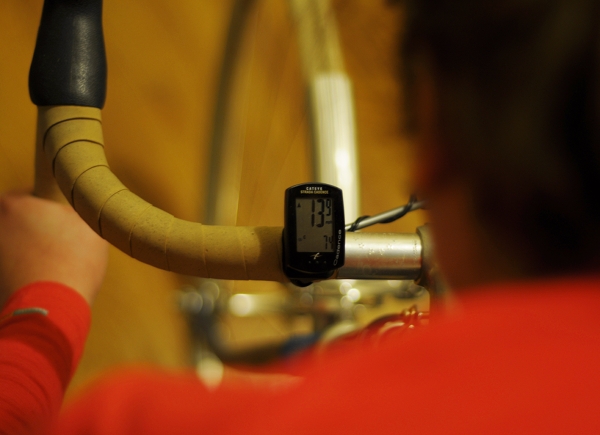 Thanks to the Co-Habitant's love of gadgets, I now have a new cycling computer with an extra feature that measures cadence (the rate at which the cyclist is pedaling). He thought it would be neat to know what mine is, because of my apparently peculiar tendency to not get out of breath while cycling. Even if I am going quite fast (I got my speed up to 20-25mph on flat groundover the course of last summer), my legs get tired, but at no point am I out of breath. For a while, I thought that this was normal and that cycling was inherently an anaerobic activity. But some road cyclists have since told me that if my heart rate is not elevated, then I am "doing it wrong" and need to measure my cadence.
Thanks to the Co-Habitant's love of gadgets, I now have a new cycling computer with an extra feature that measures cadence (the rate at which the cyclist is pedaling). He thought it would be neat to know what mine is, because of my apparently peculiar tendency to not get out of breath while cycling. Even if I am going quite fast (I got my speed up to 20-25mph on flat groundover the course of last summer), my legs get tired, but at no point am I out of breath. For a while, I thought that this was normal and that cycling was inherently an anaerobic activity. But some road cyclists have since told me that if my heart rate is not elevated, then I am "doing it wrong" and need to measure my cadence.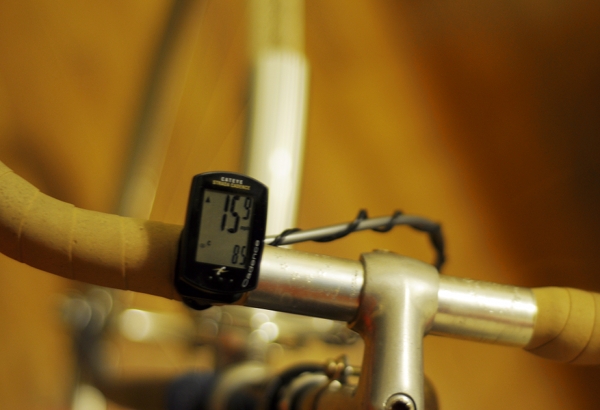 Well, all right. So I have the special computer now and can measure it. I switched to a lower gear and pedaled as fast as I could to see when my heart would start to beat faster. It happened after I reached a cadence of 90 and stayed there for 3.5 minutes. I am out of shape now compared to how I was over the summer, so back then I am sure it was higher. Because I don't like feeling out of breath, my natural rhythm on the trainer is a cadence of around 75-85 - at which point my heart rate is just a tiny bit elevated and I can keep pedaling for quite a long time while absorbed in a movie.
Well, all right. So I have the special computer now and can measure it. I switched to a lower gear and pedaled as fast as I could to see when my heart would start to beat faster. It happened after I reached a cadence of 90 and stayed there for 3.5 minutes. I am out of shape now compared to how I was over the summer, so back then I am sure it was higher. Because I don't like feeling out of breath, my natural rhythm on the trainer is a cadence of around 75-85 - at which point my heart rate is just a tiny bit elevated and I can keep pedaling for quite a long time while absorbed in a movie.So: normal or unusual? As often happens, attempts to look it up have produced wildly different answers.I have a fairly low resting heart rate (in the 50s bpm), which might also account for why I am not usually out of breath when cycling. But for the most part, I would just like to understand what I should be aiming for in terms of cadence, and whether it is even important to a non-competitive cyclist. For those of you who ride a roadbike: Do you know what your cadence is, and do you care?
Tuesday, July 21, 2009
Mixte vs Mixte: What's the Difference?
Mixte-frame bicycles have become popular again over the past couple of years, with many women buying them, or considering buying them. But what kind of bicycle is it that they are looking for? Mixtes can differ from one another considerably, both in looks and in ride quality: You cannot assume that because you have ridden one, you know them all. Just to give you an example, I have prepared a side-by-side comparison between my custom Royal H. mixte and the Rivendell Betty Foy.It takes some time to train your eye to differentiate between bicycles that may seem similar at first glance. But see whether you can get a sense of the differences just by looking at the pictures.
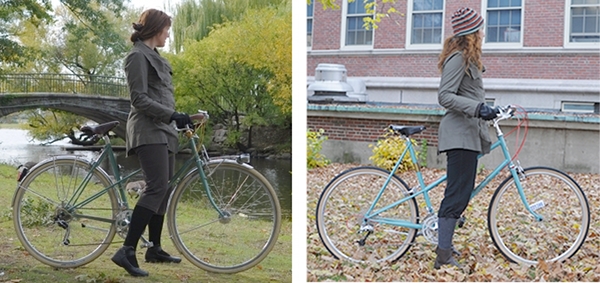 To break it down, I will describe the most obvious and significant differences between these mixtes' geometries. And as an aside to the experts out there: If you are cringing at my explanations, please keep in mind that I am trying to make this as visual as possible, as opposed to as technical as possible!
To break it down, I will describe the most obvious and significant differences between these mixtes' geometries. And as an aside to the experts out there: If you are cringing at my explanations, please keep in mind that I am trying to make this as visual as possible, as opposed to as technical as possible!
Overall proportions
Take a close look at the overall "body types" of the two bicycles. Despite their being the same size in relation to me, my custom mixte has a "short and fat" look to her, whereas the Betty Foy looks "tall and skinny". That is because my mixte is dominated by the round forms of the large wheels, whereas the Betty is dominated by the angular forms of the large frame. The Betty Foy has smaller wheels, so the frame automatically needs to be larger in order for the overall bicycle to be the same size as mine. This also explains why my mixte frame is 52cm and the Betty Foy frame is 58cm - yet when the bicycles are assembled they are both my size.
The "short and fat" vs "tall and skinny" difference between the two bikes is accentuated by the position of the handlebars. The handlebars on the Betty Foy are set higher, with some stem showing - which further elongates Betty's "body." The handlebars on my mixte are pushed almost all the way down - which accentuates the round look. Both bicycles were designed to be set up with the handlebars in these respective positions.
If you look at the vintage René Herse mixtes in this post from last year, as well as at some modern bicycles that emulate them, you will notice that they all have similar proportions to my custom mixte. Not a coincidence, because that is the look I was going for. The Rivendell Betty Foy, on the other hand, is a more contemporary take on the mixte and does not conform to this traditional design. Other modern framebuilders have taken a similar approach - playing with proportions to create their own versions.
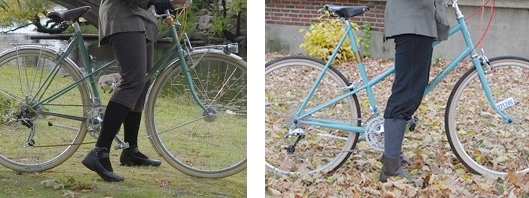 Wheelbase
Wheelbase
"Wheelbase" is the distance between the center of the front and the rear wheel of a bicycle. But to get a more concrete idea of what that means, look at the space between the wheels.On my custom mixte (left) you can see that the wheels are fairly close together, while on the Betty Foy (right) there is an enormous amount of space between the wheels.
Another easy difference to spot is the length of the chainstays. The chainstays are those skinny tubes on the frame that run parallel to the ground along the rear wheel. If you look closely, on the Betty Foy these are considerably longer than on my mixte.
Angles
The angles of a frame are actually directly related to the wheelbase, but I am not going to go into this here and will discuss angles separately.
Even without measuring, you can see in the side by side pictures, that both the seat tube and the head tube on the Betty Foy are more relaxed (they lean further back) than on my custom mixte. The difference in angles is actually very small (1 degree difference in the seat tubes and 2 degree difference in the head tubes), which makes it all the more interesting that it is visually apparent. Even a small difference can be important.
Step-over height
Not related to any of the previous factors, but worth mentioning, is that the Betty Foy top tube is lower than my mixte's twin lateral stays. On the Betty this was achieved by virtue of not continuing the top tube in a straight line after the seat post, but angling it a bit. This angle produces a similar effect to creating a "swoop" or slight loop in the frame's top tube. It is still not as easy to step over as a step-through, but it is lower than other mixtes out there.
 Ride quality
Ride quality
If you have managed to read this far and not fall asleep or close your browser window, you are probably wondering how these features affect ride quality. After all, it is useful to be able to look at a bike and have an idea of how it rides compared to other bikes.
Speaking very generally and summarily, bicycles with a longer wheelbase and more relaxed angles tend to feel more comfortable and stable, whereas bicycles with a shorter wheelbase and steeper angles tend to feel more aggressive and maneuverable. Of all these qualities, comfort is the most subjective - and also depends on other factors (such as tubing material and tires) that are independent of geometry. I would say that my custom mixte is equally comfortable to the Betty Foy - which means that the builder must have done something to enhance comfort despite the steeper angles and shorter wheelbase. As for the other factors, my mixte is indeed aggressive in comparison to Betty, with a ride quality that feels more "zesty." Both bicycles are fast and stable, but mine is quicker to accelerate and a tad more responsive, whereas Betty is more even-tempered.
Either of those qualities can be considered a virtue, depending on the cyclist's needs: A mixte like the Betty Foy is a better idea if you are looking for a relaxed, even-paced ride, whereas a mixte like mine will be more enjoyable if you want something more racy. And it helps to recognise which is which by looking at them.
 To break it down, I will describe the most obvious and significant differences between these mixtes' geometries. And as an aside to the experts out there: If you are cringing at my explanations, please keep in mind that I am trying to make this as visual as possible, as opposed to as technical as possible!
To break it down, I will describe the most obvious and significant differences between these mixtes' geometries. And as an aside to the experts out there: If you are cringing at my explanations, please keep in mind that I am trying to make this as visual as possible, as opposed to as technical as possible!Overall proportions
Take a close look at the overall "body types" of the two bicycles. Despite their being the same size in relation to me, my custom mixte has a "short and fat" look to her, whereas the Betty Foy looks "tall and skinny". That is because my mixte is dominated by the round forms of the large wheels, whereas the Betty is dominated by the angular forms of the large frame. The Betty Foy has smaller wheels, so the frame automatically needs to be larger in order for the overall bicycle to be the same size as mine. This also explains why my mixte frame is 52cm and the Betty Foy frame is 58cm - yet when the bicycles are assembled they are both my size.
The "short and fat" vs "tall and skinny" difference between the two bikes is accentuated by the position of the handlebars. The handlebars on the Betty Foy are set higher, with some stem showing - which further elongates Betty's "body." The handlebars on my mixte are pushed almost all the way down - which accentuates the round look. Both bicycles were designed to be set up with the handlebars in these respective positions.
If you look at the vintage René Herse mixtes in this post from last year, as well as at some modern bicycles that emulate them, you will notice that they all have similar proportions to my custom mixte. Not a coincidence, because that is the look I was going for. The Rivendell Betty Foy, on the other hand, is a more contemporary take on the mixte and does not conform to this traditional design. Other modern framebuilders have taken a similar approach - playing with proportions to create their own versions.
 Wheelbase
Wheelbase"Wheelbase" is the distance between the center of the front and the rear wheel of a bicycle. But to get a more concrete idea of what that means, look at the space between the wheels.On my custom mixte (left) you can see that the wheels are fairly close together, while on the Betty Foy (right) there is an enormous amount of space between the wheels.
Another easy difference to spot is the length of the chainstays. The chainstays are those skinny tubes on the frame that run parallel to the ground along the rear wheel. If you look closely, on the Betty Foy these are considerably longer than on my mixte.
Angles
The angles of a frame are actually directly related to the wheelbase, but I am not going to go into this here and will discuss angles separately.
Even without measuring, you can see in the side by side pictures, that both the seat tube and the head tube on the Betty Foy are more relaxed (they lean further back) than on my custom mixte. The difference in angles is actually very small (1 degree difference in the seat tubes and 2 degree difference in the head tubes), which makes it all the more interesting that it is visually apparent. Even a small difference can be important.
Step-over height
Not related to any of the previous factors, but worth mentioning, is that the Betty Foy top tube is lower than my mixte's twin lateral stays. On the Betty this was achieved by virtue of not continuing the top tube in a straight line after the seat post, but angling it a bit. This angle produces a similar effect to creating a "swoop" or slight loop in the frame's top tube. It is still not as easy to step over as a step-through, but it is lower than other mixtes out there.
 Ride quality
Ride qualityIf you have managed to read this far and not fall asleep or close your browser window, you are probably wondering how these features affect ride quality. After all, it is useful to be able to look at a bike and have an idea of how it rides compared to other bikes.
Speaking very generally and summarily, bicycles with a longer wheelbase and more relaxed angles tend to feel more comfortable and stable, whereas bicycles with a shorter wheelbase and steeper angles tend to feel more aggressive and maneuverable. Of all these qualities, comfort is the most subjective - and also depends on other factors (such as tubing material and tires) that are independent of geometry. I would say that my custom mixte is equally comfortable to the Betty Foy - which means that the builder must have done something to enhance comfort despite the steeper angles and shorter wheelbase. As for the other factors, my mixte is indeed aggressive in comparison to Betty, with a ride quality that feels more "zesty." Both bicycles are fast and stable, but mine is quicker to accelerate and a tad more responsive, whereas Betty is more even-tempered.
Either of those qualities can be considered a virtue, depending on the cyclist's needs: A mixte like the Betty Foy is a better idea if you are looking for a relaxed, even-paced ride, whereas a mixte like mine will be more enjoyable if you want something more racy. And it helps to recognise which is which by looking at them.
Sunday, July 19, 2009
Life in Longmire
 It certainly is snowy here at Longmire. Check out the image of my government issue house. It's almost a snowcave, and those are some serious icicles too. Don't mess with them.
It certainly is snowy here at Longmire. Check out the image of my government issue house. It's almost a snowcave, and those are some serious icicles too. Don't mess with them. Life is pretty mellow up at Mt. Rainier during the winter. It's great getting out out of Seattle a few days a week to come here. The routine so far has been: hang out in the office (i.e. scheme ways to improve the blog and seek grants for an artist in residence program), go out skiing with climbing ranger Chris Olson (i.e. risk my life following a great skier through steep treed terrain), then hang out at Mike's house (who could be a smashing restaurateur: grilled chops and salmon, mojitos, and lemon drops). Rough life, I know.
 Since Chris is pretty much a professional skier and will turn his boards down anything in any conditions, hanging out with him has been an adventure so far. During our first day out a few weeks ago (when the sun last revealed itself), we skied bulletproof ice from Panorama Point to Paradise. The saving grace was crystal clear skies, letting us see almost every big peak in Washington and Oregon. (Right: Chris at Panorama Point).
Since Chris is pretty much a professional skier and will turn his boards down anything in any conditions, hanging out with him has been an adventure so far. During our first day out a few weeks ago (when the sun last revealed itself), we skied bulletproof ice from Panorama Point to Paradise. The saving grace was crystal clear skies, letting us see almost every big peak in Washington and Oregon. (Right: Chris at Panorama Point).Once, we skied partway up the Eagle Peak trail then came down in the dark through the trees. It was like being on a roller coaster where you couldn't see the next twist or turn until you came right up on it. Or, as Chris put it in his ski report, it "felt like a bobsled run in the dark." Of course, he wrote that after skiing the trail by himself and blazing down it at about 50 mph. Anyway, we skied it the next day together and came down at a more leisurely pace but it still felt fast to me!
 The ski up through the old growth forest was beautiful, with fluffy snow everywhere. Piled in soft pillows all around us, hanging from the trees, falling from the sky. I felt like I was living in a Christmas carol. (Left: Chris leads the way up the "bobsled run")
The ski up through the old growth forest was beautiful, with fluffy snow everywhere. Piled in soft pillows all around us, hanging from the trees, falling from the sky. I felt like I was living in a Christmas carol. (Left: Chris leads the way up the "bobsled run")I was also thinking what a great trail this was for snowshoers, when Chris pointed out how easy it would be to get lost if you didn't know exactly where the trail was. (He was amazed that the trail was still visible through all the recent snow). I realized that he was right and suddenly got a little less complacent about it - especially when he reminded me that a hiker died on this trail last June.
Then again, if anyone knows his way around here, it's probably Chris. The problem is, if you follow him up something, you also have to follow him down.
Saturday, July 18, 2009
Benjamin's Calabash Seafood Buffet

I don't tend to write about the places we eat at that often. We don't eat out tons and when we do it tends to be when we are out on a date so I'm not thinking of taking the camera out then. I really couldn't resist this week though. We saw a bunch of advertising for different seafood buffets and it had me wanting to sample one before we left. We picked Benjamin's Calabash Seafood Buffet as our pick.
The place was very nice, our service was terrific and with over 170 items on the buffet-we ate more than enough seafood before we left. Yummy!

Afterwards we went to Outdoor World/Bass Pro Shop and I have to tell ya, the guys just crack me up in this store. It is one of the few places that Nathan actually enjoys shopping at and Austin has every camo inspired gadget that he could dream of all in one place.

Living the life in South Carolina!
Thursday, July 16, 2009
The Gift WI4R, First Ascent SWPA
Laura and I made a last minute decision that based on the poor (warm) future SWPA forecast, we needed to climb whatever we could find, before it was gone! We quickly agreed that Sunday School Crag would be our destination since it resides at a higher elevation than most other SWPA crags. It also receives little to no sun. If anything was "in" it would be Sunday School. On New Year's Day Laura and I hiked in to try to climb, but poor conditions kept us off the ice. We took note of a line that was forming just right of the line we did last year Late Bloomer. It looked like a lot of fun, but we figured it was better left for safer conditions. Today was that day, although the conditions weren't much safer. When we left home it was humid and the thermometer was reading 31°. The snow in our yard has compressed considerably leaving us worried for what we'd find at the crag. It wasn't much colder at the parking area, but there was still several feet of snow that required us to snowshoe the approach.
The approach isn't long, but what it lacks in distance it makes up for in terrain. On most average days its an invigorating 30 min. hump that takes a few trips to truly "appreciate". We made the hump at slower than normal pace trying not to overheat too much despite not wearing much at all. When the climb came into view I was puzzled that the climb hadn't built much more than what we had seen on New Years Day. I could audibly hear lots of running water which didn't instill much confidence, despite this we trekked onward to base camp.
With a severe warm-up looming in the next few days, I looked the climb over and quickly decided it was "good enough" to at least get on and test the start. Since last ice season was pretty much a no show, I'veonly climbed a few pitches of pure ice over the last several years. I was seriously hoping I remembered how to ice climb ;) A reasonably solid ice start provided me with a confidence building screw.
The good ice quickly faded as I continued up a snow ramp pulling off eyelids and exposing underlying sloping limestone defunct of edges. I tiptoed my way up to the next bit of "ice" that provided a few insecure screws and eventually an icicle worth slinging accompanied by a small 12" diameter column that seemed more solid than anything thus far. This set me off right across another sloping, snow encrusted ledge which crumbled and exposed more slick limestone for my feet.
I eventually reached somewhat solid ice a little higher up and the first good screws of the climb. A short 15' pillar ended at more snow covered limestone which provided a very exciting, hollowed ice and rock top-out.
I slogged up through deep snow to the base of the lower angled ice above and found that it was melting out fast and poorly bonded. The true climbing was over and the quickly deteriorating ice above helped me decide that the route was finished at that point. I quickly set up the most secure belay I could muster and prepared to bring Laura up. She progressed up the climb enjoying every move. She found it to be boney and melting out quickly, as did I. We shared a brief moment at the belay and snapped a few photos for memories.
I gently lowered Laura down supporting most of her body weight with mine, carefully trying not to involve the anchor if necessary. With Laura safely on the ground I quickly utilized the best ice available and built a V-thread and rapped down without sacrificing anything, but cord.
The climb was a great season opener and a lot of fun, but the unpleasant sounds of ice falling off the walls around us, we knew we overstayed our welcome. We packed up and snowshoed back to the car. I snapped a few photos of the deteriorating ice for giggles. We decided to name the route The Gift WI4R in current conditions. We decided it was "The Gift" from mother nature, since she didn't offer very favorable ice seasons the last several seasons. Hopefully this isn't all we'll get this season. Stay tuned...
 |
| Laura snowshoeing to Sunday School Crag |
The approach isn't long, but what it lacks in distance it makes up for in terrain. On most average days its an invigorating 30 min. hump that takes a few trips to truly "appreciate". We made the hump at slower than normal pace trying not to overheat too much despite not wearing much at all. When the climb came into view I was puzzled that the climb hadn't built much more than what we had seen on New Years Day. I could audibly hear lots of running water which didn't instill much confidence, despite this we trekked onward to base camp.
 |
| Laura happy to be at "base camp" |
With a severe warm-up looming in the next few days, I looked the climb over and quickly decided it was "good enough" to at least get on and test the start. Since last ice season was pretty much a no show, I'veonly climbed a few pitches of pure ice over the last several years. I was seriously hoping I remembered how to ice climb ;) A reasonably solid ice start provided me with a confidence building screw.
 |
| Starting up The Gift WI4 through the ice start |
The good ice quickly faded as I continued up a snow ramp pulling off eyelids and exposing underlying sloping limestone defunct of edges. I tiptoed my way up to the next bit of "ice" that provided a few insecure screws and eventually an icicle worth slinging accompanied by a small 12" diameter column that seemed more solid than anything thus far. This set me off right across another sloping, snow encrusted ledge which crumbled and exposed more slick limestone for my feet.
 |
| The base of the short pillar and best ice on the route |
I eventually reached somewhat solid ice a little higher up and the first good screws of the climb. A short 15' pillar ended at more snow covered limestone which provided a very exciting, hollowed ice and rock top-out.
 |
| Topping out the pillar |
I slogged up through deep snow to the base of the lower angled ice above and found that it was melting out fast and poorly bonded. The true climbing was over and the quickly deteriorating ice above helped me decide that the route was finished at that point. I quickly set up the most secure belay I could muster and prepared to bring Laura up. She progressed up the climb enjoying every move. She found it to be boney and melting out quickly, as did I. We shared a brief moment at the belay and snapped a few photos for memories.
 |
| Self portrait of the happy couple at the anchor |
I gently lowered Laura down supporting most of her body weight with mine, carefully trying not to involve the anchor if necessary. With Laura safely on the ground I quickly utilized the best ice available and built a V-thread and rapped down without sacrificing anything, but cord.
 |
| Laura says... How could you not smile after climbing "The Gift" |
The climb was a great season opener and a lot of fun, but the unpleasant sounds of ice falling off the walls around us, we knew we overstayed our welcome. We packed up and snowshoed back to the car. I snapped a few photos of the deteriorating ice for giggles. We decided to name the route The Gift WI4R in current conditions. We decided it was "The Gift" from mother nature, since she didn't offer very favorable ice seasons the last several seasons. Hopefully this isn't all we'll get this season. Stay tuned...
 |
| Meltdown... a common sight today |
 |
| Fractures common as well |
 |
| Where's Waldo? Center of photo in the right chute |
Sunday, July 12, 2009
Monday Mailbox: How to Unclip in Time If Your Bike Stalls Out Uphill?

Monday Mailbox is a weekly post dedicated to questions received over email. Here is one I've been asked by new riders on a few occasions:
I see that you use clipless pedals, and that you do some rides with steep hills. How do you make sure to unclip in time and keep from falling over if your bike runs out of gears and stalls out on a steep climb? I would like to try clipless pedals, but this part makes me nervous.
I am going to answer this question literally - as in how do Ihandle this situation. It may not be the most elegant or standard way to do it, but it works for me.
If I'm in my lowest gear already and a hill is so steep that I sense I am coming to a complete stop, I make one last effort to push on the pedals with all my force and heave the bike forward. This buys me the extra bit of momentum I need to unclip and put my foot down calmly.
But in general, with clipless pedals the key is not to panic. Once you get used to the system, unclipping should be instantaneous. So even if your bike comes to a complete stop and starts falling over to one side, there is still time to unclip - as long as you don't panic and "forget" how to do it.
And on a separate note: If youfrequentlyfind yourself running out of gears uphill to the point of stalling out and having to walk, consider that your bike may have the wrong gearing for your style of riding or ability. Talk to your local bike shop about lowering your gearing; most likely it will mean swapping out the rear cassette and will not be too expensive. Being able to ride all the way up a hill beats having to stop - whether you ride with clipless pedals or not.
Saturday, July 11, 2009
Friday, July 10, 2009
Their Roots are Showing
Friday, February 15th - - Today was a travel day. I left Big Lagoon State Park in Florida and ended up in Monroe, Louisiana by late afternoon. There I would spend the weekend visiting with my distant Joslin cousins, Sue and Joann (with whom I have traveled in the past), as well as their sisters Missy and Sally, and of course, their mother Ruth. Joann's son, Matt and his two children were also visiting so I had the chance to meet them. Sue wrote about their visit to the cabin - she has some really nice photos of the kids. It was great to see them all again! Thank you, once again, for your hospitality.
Monday, February 18th - - Departed Monroe, Louisiana and traveled westward on Interstate 20 then south to the Martin Dies Jr. State Park a few miles west of Jasper, Texas. The forecast called for rain, and that is what Mother Nature delivered, with intensity at times.

The sky brightened up a bit as the sun was going down, but the break didn't last long - it rained throughout the night.

By morning, the rain and clouds were gone and blue skies were all around. There are two rivers that join together at Martin Dies Jr. State Park. I don't know which one this is but the water was low - perhaps because of the extended drought in Texas the last few years.

If you've ever wondered what the root system of a Cypress tree looked like, now you know! I'm guessing that there is one large "tap-root" that extends further down into the ground that supports each clump of trees.
I traveled further westward and south a bit to South Llano River State Park. Located a few miles south of Junction in central Texas, along Interstate 10. I had picked up a "bug" just before getting to Monroe that got worse as time went on. It started as a sore throat, then coughing, and then a headache and sinus pressure. I finally gave in after five days and went to a medical clinic in Junction where I was prescribed an antibiotic and cough syrup. Within two days I was feeling much better. Thank you very much!
South Llano River State Park is a nice park. The campground was great, one of the nicer ones in the Texas State park system (in my opinion). The sites are large with lots of space in-between each site. You pick your own site so can select a shaded or sunny site, whichever you desire. It was a good place to simply lounge around and recover from a minor illness. I did take advantage of some of the shorter trails and took a walk most every day. The weather couldn't have been better - well, except for the one day (Monday, the 25th) when the temperature dropped into the 50s and the wind gusted up to 50 mph! That day was mostly spent at the library!
Wednesday, February 27th - - Another travel day. Finally feeling well enough to move on... heading further south.
Wednesday, March 6th- - I know you are wondering - Where am I now? I will say this - I'm still in Texas, just not as far south as I was this past week!
Monday, February 18th - - Departed Monroe, Louisiana and traveled westward on Interstate 20 then south to the Martin Dies Jr. State Park a few miles west of Jasper, Texas. The forecast called for rain, and that is what Mother Nature delivered, with intensity at times.

The sky brightened up a bit as the sun was going down, but the break didn't last long - it rained throughout the night.

By morning, the rain and clouds were gone and blue skies were all around. There are two rivers that join together at Martin Dies Jr. State Park. I don't know which one this is but the water was low - perhaps because of the extended drought in Texas the last few years.

If you've ever wondered what the root system of a Cypress tree looked like, now you know! I'm guessing that there is one large "tap-root" that extends further down into the ground that supports each clump of trees.
I traveled further westward and south a bit to South Llano River State Park. Located a few miles south of Junction in central Texas, along Interstate 10. I had picked up a "bug" just before getting to Monroe that got worse as time went on. It started as a sore throat, then coughing, and then a headache and sinus pressure. I finally gave in after five days and went to a medical clinic in Junction where I was prescribed an antibiotic and cough syrup. Within two days I was feeling much better. Thank you very much!
South Llano River State Park is a nice park. The campground was great, one of the nicer ones in the Texas State park system (in my opinion). The sites are large with lots of space in-between each site. You pick your own site so can select a shaded or sunny site, whichever you desire. It was a good place to simply lounge around and recover from a minor illness. I did take advantage of some of the shorter trails and took a walk most every day. The weather couldn't have been better - well, except for the one day (Monday, the 25th) when the temperature dropped into the 50s and the wind gusted up to 50 mph! That day was mostly spent at the library!
Wednesday, February 27th - - Another travel day. Finally feeling well enough to move on... heading further south.
Wednesday, March 6th- - I know you are wondering - Where am I now? I will say this - I'm still in Texas, just not as far south as I was this past week!
Tuesday, July 7, 2009
The Amazing Bloomin' Cactus
This Christmas Cactus was given to me six years ago when it was about 6 inches high. Now it is 24 inches across and the highest branch is 15 inches high; the pot is 7 inches high. The first half dozen flowers bloomed last weekend. I counted 20 full blooms, 6 more ready to bloom, 10 medium sized buds and more than 50 small buds just coming on. It is incredibly beautiful, the pictures in no way do it justice but I just had to share. The most blooms that have ever been on it at the same time has been six. Has anyone ever seen a Christmas Cactus with so many flowers?






Sunday, July 5, 2009
Sackville Trunksack: How Fitting for a Rear Rack!
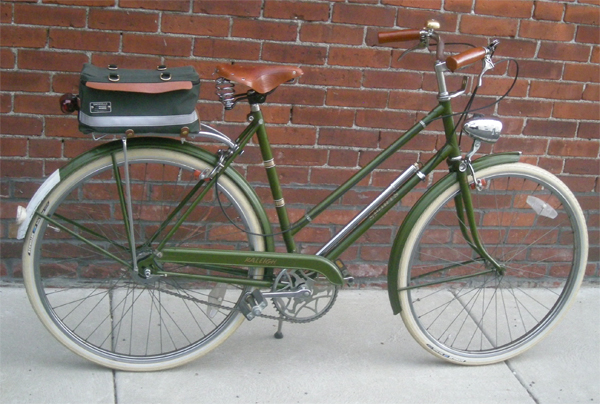 I have talked ad nauseum about my Carradice Barley bag, and so I thought it was time to review my other bag, the Sackville Trunksack. As far as I know, it is available exclusively from Rivendell, and you can read their product description here.
I have talked ad nauseum about my Carradice Barley bag, and so I thought it was time to review my other bag, the Sackville Trunksack. As far as I know, it is available exclusively from Rivendell, and you can read their product description here.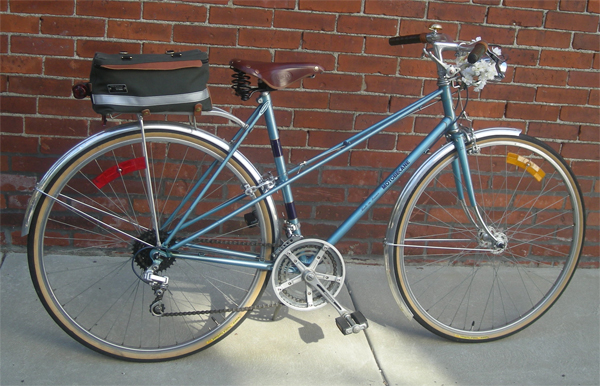 The Sackville Trunksack is a handsome box-shaped bag, in a dark-olive waterproof canvas with golden-brown leather trim and brass hardware. The large size is designed for the rear rack. It fits Pletscher-style racks perfectly, neither leaving portions of the rack uncovered, nor overhanging from any part of the rack. It looks great on many different types of bicycles, including the Motobecane mixte above and the Raleigh Lady's Sport on the first photo.
The Sackville Trunksack is a handsome box-shaped bag, in a dark-olive waterproof canvas with golden-brown leather trim and brass hardware. The large size is designed for the rear rack. It fits Pletscher-style racks perfectly, neither leaving portions of the rack uncovered, nor overhanging from any part of the rack. It looks great on many different types of bicycles, including the Motobecane mixte above and the Raleigh Lady's Sport on the first photo.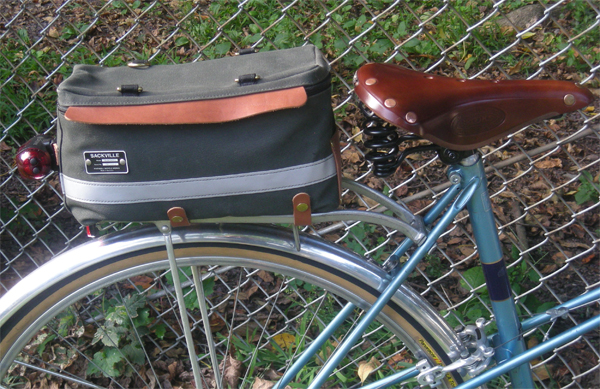 Here are some views of the bag. The zipper closure with two separate zippers is very convenient, as it allows you to open and close the bag from any side while remaining seated on the bicycle.
Here are some views of the bag. The zipper closure with two separate zippers is very convenient, as it allows you to open and close the bag from any side while remaining seated on the bicycle.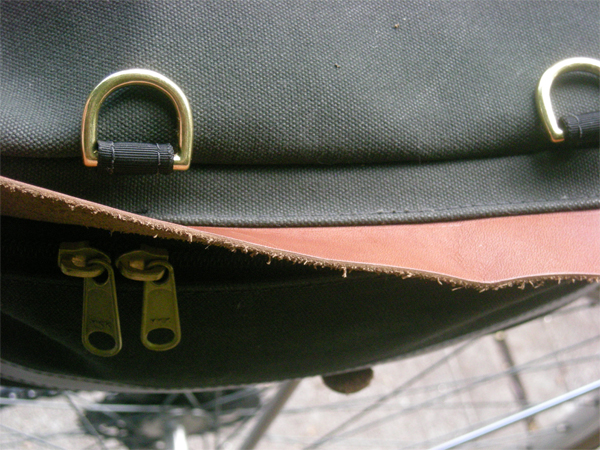 The leather flaps hide the zippers from view and prevent rain from entering.
The leather flaps hide the zippers from view and prevent rain from entering.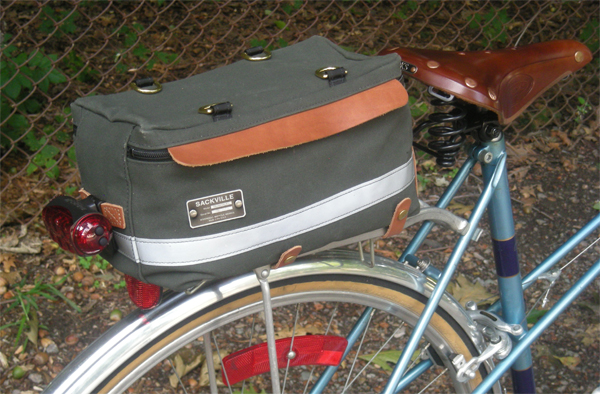 3/4 view. The colour of the leather flap is an exact match for Brooks "honey" (pictured ont he 1st photo of the Raleigh here) and a shade lighter than the Brooks "brown" (above). The reflective strip is an extra benefit.
3/4 view. The colour of the leather flap is an exact match for Brooks "honey" (pictured ont he 1st photo of the Raleigh here) and a shade lighter than the Brooks "brown" (above). The reflective strip is an extra benefit.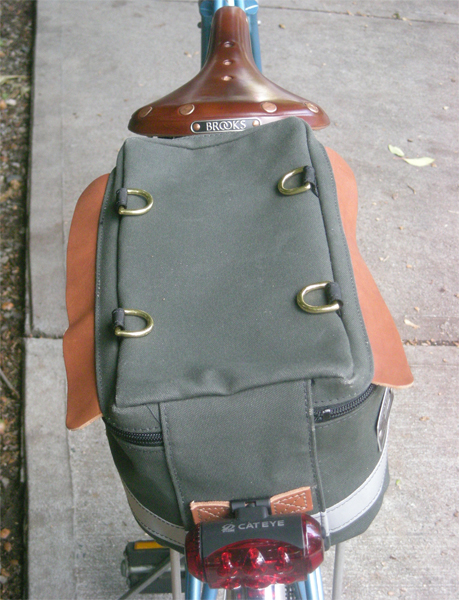 Rear view. The leather strap in the back is positioned perfectly for mounting a light, providing a great solution for rear lighting (if you recall, this was my only criticism of the Carradice Barley).
Rear view. The leather strap in the back is positioned perfectly for mounting a light, providing a great solution for rear lighting (if you recall, this was my only criticism of the Carradice Barley).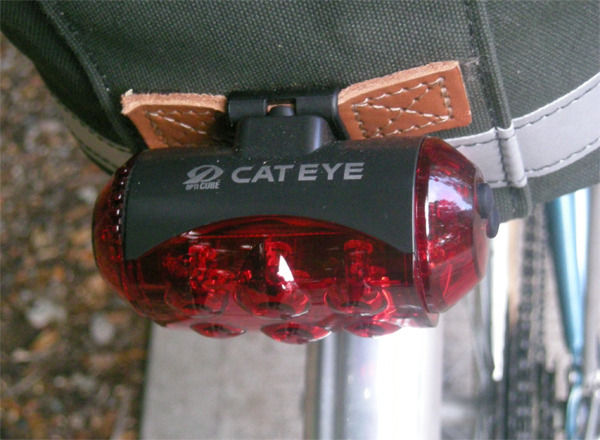 Close-up of the light attachment. Very secure; no wobbling or slanting even during very bumpy rides.
Close-up of the light attachment. Very secure; no wobbling or slanting even during very bumpy rides. The complete lack of wobble is one of the biggest benefits of the Sackville Trunksack. This is achieved by the tight and precise attachment system: leather straps with snap closure.
The complete lack of wobble is one of the biggest benefits of the Sackville Trunksack. This is achieved by the tight and precise attachment system: leather straps with snap closure.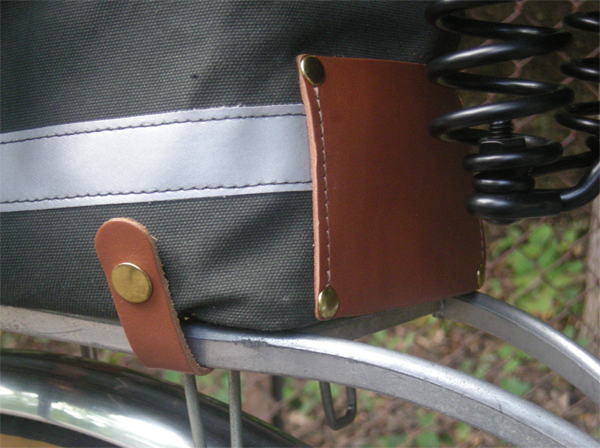 The brass hardware is rather attractive.
The brass hardware is rather attractive.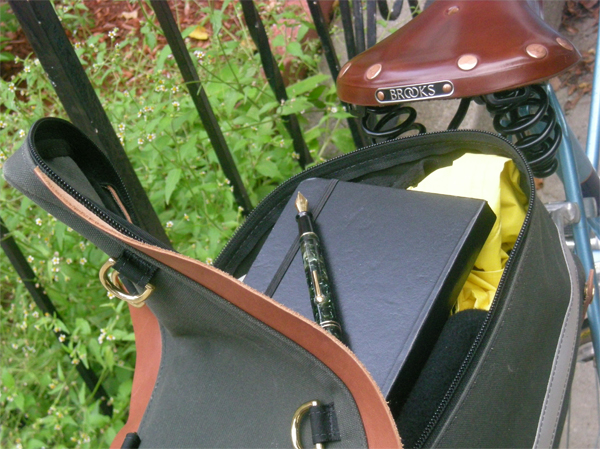 Inside, the Trunksack is like a large box or chest: There are no compartments. This can be both a good thing and a bad thing. It is good in the sense that you need only to open it once, and all of your stuff is immediately accessible. And it is bad in the sense that, especially if you are messy, your things will soon become jumbled due to the lack of compartments. For me, the benefits of the ease of access outweigh the drawbacks of the lack of compartments - but this is a personal preference.
Inside, the Trunksack is like a large box or chest: There are no compartments. This can be both a good thing and a bad thing. It is good in the sense that you need only to open it once, and all of your stuff is immediately accessible. And it is bad in the sense that, especially if you are messy, your things will soon become jumbled due to the lack of compartments. For me, the benefits of the ease of access outweigh the drawbacks of the lack of compartments - but this is a personal preference.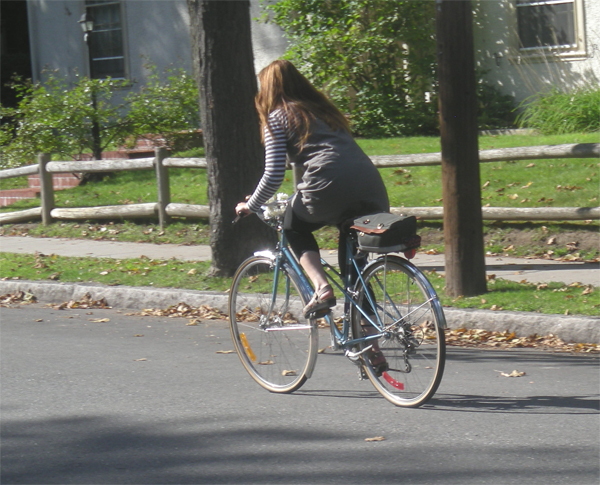 My one complaint about the Sackville Trunksack, is that it has no structural support and therefore does not retain its form unless it is full. You can see that almost all the photos show various degrees of sagging. We are trying to make a support for it either out of wire or plexiglass, but it is not yet complete. In the meantime, I try to keep it maximally filled.
My one complaint about the Sackville Trunksack, is that it has no structural support and therefore does not retain its form unless it is full. You can see that almost all the photos show various degrees of sagging. We are trying to make a support for it either out of wire or plexiglass, but it is not yet complete. In the meantime, I try to keep it maximally filled.To sum up what I love about the Sackville Trunksack:
. It fits my rear rack perfectly, securely and free of wobble
. The box shape and the colour scheme are aesthetically appealing
. It is very roomy
. The single zip closure provides easy access
. It is waterproof
. The rear light attachment is excellently designed
And what could use improvement, is the sagging issue.
Edited to add: As of April , I no longer own this bag - having traded it to a fellow collector for another bicycle-related item. I liked the bag, but ultimately prefer Carradice-style saddlebags.
Subscribe to:
Comments (Atom)
 There were these big metal vases or pots by the entrance to one shop.
There were these big metal vases or pots by the entrance to one shop.